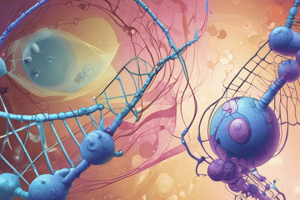Podcast
Questions and Answers
What are antimetabolites and how do they work in chemotherapy?
What are antimetabolites and how do they work in chemotherapy?
Antimetabolites are chemotherapy drugs that interfere with the normal metabolic processes of cells, particularly those involved in DNA synthesis and repair. They mimic essential cellular components, leading to disruptions in vital cellular functions.
Name two types of pyrimidine antimetabolites and their mechanisms of action.
Name two types of pyrimidine antimetabolites and their mechanisms of action.
Fluorouracil (5-FU) resembles uracil and inhibits thymidylate synthase, disrupting DNA synthesis. Capecitabine is an oral prodrug of 5-FU, converted to active form in the body.
What are purine antimetabolites and how do they disrupt cell metabolism?
What are purine antimetabolites and how do they disrupt cell metabolism?
Purine antimetabolites such as Mercaptopurine (6-MP) and Azathioprine resemble purines, disrupting DNA and RNA synthesis.
What is the mechanism of action of Methotrexate as a folate antagonist?
What is the mechanism of action of Methotrexate as a folate antagonist?
Name a deoxynucleotide analog antimetabolite and describe its impact on DNA synthesis.
Name a deoxynucleotide analog antimetabolite and describe its impact on DNA synthesis.
Flashcards are hidden until you start studying
Study Notes
Antimetabolites in Chemotherapy
- Antimetabolites are a class of chemotherapy drugs that interfere with the metabolism of cancer cells by mimicking essential nutrients, thereby disrupting cellular processes.
- They work by replacing the normal cellular building blocks, such as nucleotides, amino acids, and vitamins, with abnormal molecules that cannot be used by the cell.
Pyrimidine Antimetabolites
- 5-Fluorouracil (5-FU) is a pyrimidine antimetabolite that inhibits thymidylate synthase, an enzyme necessary for DNA synthesis, leading to the inhibition of cell growth.
- Cytarabine is a pyrimidine antimetabolite that is incorporated into DNA, causing DNA strand breaks and inhibiting DNA synthesis.
Purine Antimetabolites
- Purine antimetabolites, such as 6-mercaptopurine and 6-thioguanine, disrupt cell metabolism by inhibiting purine nucleotide synthesis, which is necessary for DNA and RNA synthesis.
- They work by interfering with the enzymes involved in purine biosynthesis, leading to the inhibition of cell growth and proliferation.
Folate Antagonists
- Methotrexate is a folate antagonist that inhibits the enzyme dihydrofolate reductase, which is necessary for the conversion of folate to its active form.
- This leads to a decrease in the production of thymidine, a nucleotide necessary for DNA synthesis, ultimately resulting in the inhibition of cell growth.
Deoxynucleotide Analog Antimetabolites
- Gemcitabine is a deoxynucleotide analog antimetabolite that is incorporated into DNA, leading to the inhibition of DNA synthesis and the disruption of cell growth.
- It is a potent inhibitor of ribonucleotide reductase, an enzyme necessary for the synthesis of deoxynucleotides, the building blocks of DNA.
Studying That Suits You
Use AI to generate personalized quizzes and flashcards to suit your learning preferences.



